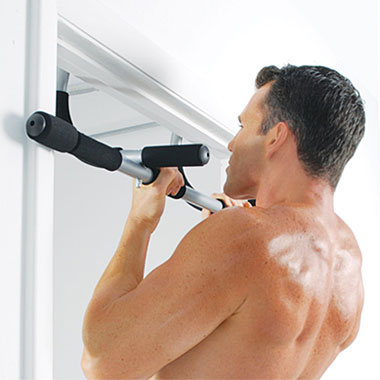- Like
- SHARE
- Digg
- Del
- Tumblr
- VKontakte
- Flattr
- Buffer
- Love This
- Save
- Odnoklassniki
- Meneame
- Blogger
- Amazon
- Yahoo Mail
- Gmail
- AOL
- Newsvine
- HackerNews
- Evernote
- MySpace
- Mail.ru
- Viadeo
- Line
- Comments
- Yummly
- SMS
- Viber
- Telegram
- JOIN
- Skype
- Facebook Messenger
- Kakao
- LiveJournal
- Yammer
- Edgar
- Fintel
- Mix
- Instapaper
- Copy Link
 Portable Pull Up Bars Are an Awesome Way to Get Stronger at Home or On-the-Go
Portable Pull Up Bars Are an Awesome Way to Get Stronger at Home or On-the-Go
The pull up is the king of all upper body exercises. Nothing gives you more bang for your buck than a well-executed pull up. Properly performed pull ups will strengthen any movement pattern requiring pulling; they’re great for your posture; they torch a ton of calories; they contribute to core, hip, and shoulder stability; and most importantly to some, they will pack mean, meaty slabs of muscle onto your upper back, shoulders, and biceps, making you look and feel totally yoked.
So how do you train pull ups at home so you can harness all these benefits if you don’t have or don’t want a gym membership for any reason? The solution is a portable pull up bar, and possibly some helpful accessories if you need to scale your pull ups down or up in terms of difficulty. There are quite a few brands and models of home door-mounted pull ups available out there, so let me help you avoid the junk and make sure you are getting a quality product.
To help you even more on your pull up quest, I’ll go into detail on how to do a pull up properly, go over a few pull up variations to suit your purposes, discuss exactly how to make pull ups easier (don’t worry if they are really hard (read: impossible) right now; train and I guarantee you will improve), and of course go over my top 5 best portable pull up / chin up bars you can buy for your home training.
Read on to get a certified personal trainer’s unbiased opinion on the pull up exercise and the best portable pull up bars.
Top 5 Best Portable Pull Up / Chin Up Bars
If you’re looking for expert instructions on how to properly do pull ups, pull up tips and tricks, pull up variations to try, how to make pull ups easier, or how to get better at pull ups, we’re going to take a look at those later in the article, however, let’s first dig into the meat of what you came here for….the top 5 best portable pull up / chin up bars!
#1. CAP Xtreme Doorway Gym
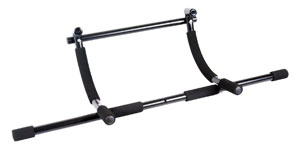 This model is super cheap and fair in terms of solidity. If budget is your main concern, this will fit the bill. It sits in the frame of your doorway without using screws and shouldn’t mar the wall. You’ll be able to do traditional overhand grip pull ups as well as underhand chin ups and neutral grip pull ups. Don’t expect rock solid construction; even with the screws all the way tight, some folks have complained of a slight feeling of jiggliness. But you certainly can’t beat the price if you’re strapped and just want a simple, cheap way to train some pull ups at home.
This model is super cheap and fair in terms of solidity. If budget is your main concern, this will fit the bill. It sits in the frame of your doorway without using screws and shouldn’t mar the wall. You’ll be able to do traditional overhand grip pull ups as well as underhand chin ups and neutral grip pull ups. Don’t expect rock solid construction; even with the screws all the way tight, some folks have complained of a slight feeling of jiggliness. But you certainly can’t beat the price if you’re strapped and just want a simple, cheap way to train some pull ups at home.
#2. Maximiza Doorway Pullup / Chinup Bar with 3 Sets of Screw-in Door-mounts
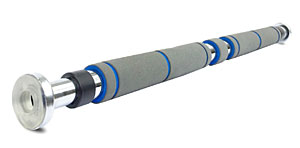 This is the only product in this review that requires screws. If you want a permanently mounted doorway pull up bar to train overhand pull ups and underhand chin ups and you don’t care about neutral grip, this product is affordable and should suit your needs perfectly. When properly mounted, this heavy-duty bar can safely handle an individual weighing up to 300 pounds. The bar is adjustable to fit doorways ranging from very narrow at 26 inches to quite wide at 36 inches. Built in foam handles help minimize slippage with sweaty hands.
This is the only product in this review that requires screws. If you want a permanently mounted doorway pull up bar to train overhand pull ups and underhand chin ups and you don’t care about neutral grip, this product is affordable and should suit your needs perfectly. When properly mounted, this heavy-duty bar can safely handle an individual weighing up to 300 pounds. The bar is adjustable to fit doorways ranging from very narrow at 26 inches to quite wide at 36 inches. Built in foam handles help minimize slippage with sweaty hands.
#3. Stamina Doorway Trainer Plus
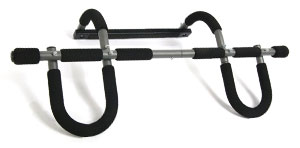 The Stamina Doorway Trainer Plus reps a step up in quality and versatility. The price is a little higher but shouldn’t be prohibitive for serious fitness folks. You’ve got five grip options to train different angles and grip widths. Durable foam grips make it a bit easier on your hands. You can also take it down to use for multigrip push ups, dips, and even sit ups! It slides in and out of your doorframe with ease rather than requiring any damaging screws. Approved for user weights up to 250 pounds, so heavier folks take note. Overall, this is a solid multifunctional portable pull up bar, great for complementing your home gym setup.
The Stamina Doorway Trainer Plus reps a step up in quality and versatility. The price is a little higher but shouldn’t be prohibitive for serious fitness folks. You’ve got five grip options to train different angles and grip widths. Durable foam grips make it a bit easier on your hands. You can also take it down to use for multigrip push ups, dips, and even sit ups! It slides in and out of your doorframe with ease rather than requiring any damaging screws. Approved for user weights up to 250 pounds, so heavier folks take note. Overall, this is a solid multifunctional portable pull up bar, great for complementing your home gym setup.
#4. ProSource Multi-Grip Chin-Up/Pull-Up Bar, Heavy Duty Doorway Trainer for Home Gym
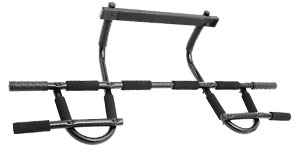 Here’s the biggest, baddest boy of the bunch as far as standard pull up bars go. I find the ProSource Multi-Grip to be the most solid and the most versatile of those I’m reviewing. Not only is it easy to hang up and take down, you’ll want to take it down a lot because you can also use it on the floor for push ups, triceps dips, and even sit up variations. For pull ups and chin ups, there are 12 different grip options to allow you to dial in different muscle fibers using different grip angles and grip widths. Also, the price is right: around $30 will score you a ProSource. Max user weight is a hefty 300 pounds which makes it accessible to most exercisers.
Here’s the biggest, baddest boy of the bunch as far as standard pull up bars go. I find the ProSource Multi-Grip to be the most solid and the most versatile of those I’m reviewing. Not only is it easy to hang up and take down, you’ll want to take it down a lot because you can also use it on the floor for push ups, triceps dips, and even sit up variations. For pull ups and chin ups, there are 12 different grip options to allow you to dial in different muscle fibers using different grip angles and grip widths. Also, the price is right: around $30 will score you a ProSource. Max user weight is a hefty 300 pounds which makes it accessible to most exercisers.
#5. Gorilla Gym Power Fitness Package (Pull Up Bar, Pullup Extender, and Ab Straps)
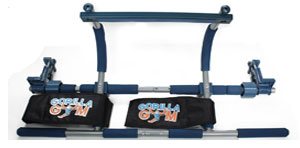 To finish off, I want to include a super solid product that comes with a couple nifty extras. The Gorilla Gym is extremely well built compared to the other options, including clamps that secure it firmly to your door frame so you can safely incorporate more advanced power movements to your pulling workouts. It also includes two arm straps that you can use to secure your arms and shoulders during hanging leg raises and other dangly abs exercises. Several grip options make sure you have the option of training your pull ups from any desired angle. The Gorilla Gym is a bit more expensive compared to the others, and it doesn’t come down easily to allow you to do push up and dip variations, but if you’re after pure pull ups, chin ups, and abs raises you are looking at the right one. It combines the security of a permanently-mounted pull up bar with the ease of the portable models, and its design won’t mar your door frame as much as some others.
To finish off, I want to include a super solid product that comes with a couple nifty extras. The Gorilla Gym is extremely well built compared to the other options, including clamps that secure it firmly to your door frame so you can safely incorporate more advanced power movements to your pulling workouts. It also includes two arm straps that you can use to secure your arms and shoulders during hanging leg raises and other dangly abs exercises. Several grip options make sure you have the option of training your pull ups from any desired angle. The Gorilla Gym is a bit more expensive compared to the others, and it doesn’t come down easily to allow you to do push up and dip variations, but if you’re after pure pull ups, chin ups, and abs raises you are looking at the right one. It combines the security of a permanently-mounted pull up bar with the ease of the portable models, and its design won’t mar your door frame as much as some others.
Expert Tips to Get the Most out of Your New Portable Pull Up Bar
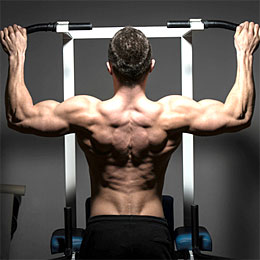 Now that we’ve taken a look at the top 5 best portable pull up / chin up bars, it’s time to learn more about pull ups….much more.
Now that we’ve taken a look at the top 5 best portable pull up / chin up bars, it’s time to learn more about pull ups….much more.
Buying a pull up bar is one thing but getting the most bang for your buck when exercising with it is another story. There is a right way and a wrong way to perform a pull up, you also have variations of the pull up to choose from, and there are even ways you can further maximize your muscle building efforts.
Continue reading to learn how to properly perform the pull up exercise, pull up variations to try, how to make pull ups easier, how to get better at pull ups, and more exercise tips & tricks to get the most out of your new home gym toy!
How to Properly Do a Pull Up
The prime movers in a pull up are the latissimus dorsi and the biceps brachii. In more simple terms, your lats and biceps. In even more simple terms, your back and arms. Notice that back is listed first for a good reason. I see a lot of people in the gym slaving over arms-only pull ups. If you don’t use your back muscles to the right extent, you will never get good at pull ups and you will be cheating yourself out of a ton of progress. Let’s break down the steps in a proper pull up.
To get set up, grab onto the bar with an overhand grip (like you’re gripping the handlebars of a bike). Your grip should be slightly wider than shoulder-width. Tighten your core and squeeze your glute muscles so your hips stay stable. Many people prefer to cross their legs at the ankles because it provides some stability and also removes the urge to “cheat” by using the lower body to create momentum.
As you begin the pull, first visualize your shoulder blades descending strongly into your back pockets and squeezing toward each other. Pull from your back muscles, bringing your elbows to the sides of your rib cage. Continue the pull from your elbows, completing the top portion of the lift by bringing your chest all the way up to the bar. As you lower yourself back to the starting position go slowly and under great control. You will develop a lot of strength on the eccentric, or lowering, part of the lift, so don’t neglect its importance. Descending slowly and while maintaining proper form will also go a long way toward building shoulder stability and protecting those shoulder structures that are all-too-easy to injure.
Here are a few tips and pointers to make sure you are doing pull ups right and getting the most out of your pull up training:
- Never tilt your head back in an attempt to get your chin over the bar; instead, keep your neck strong and stable and pull your chest up to the bar.
- Breathe out as you pull yourself up; this will help you tighten your core and get more power to boost you through the movement.
- Unless you are a gymnast or receiving adequate coaching, avoid kipping; it’s too easy to hurt yourself and the reps don’t count as real pull ups anyway.
- Don’t pull the bar behind your head; it’s generally agreed that the benefits to this do not outweigh the risk of injury
- Focus your mind on your lats during your pull ups; they sweep up from your lower back and insert on the inside of your humerus. When they contract, they are the prime movers responsible for pulling your elbows to your sides and getting your chest up to that bar. You’ll never get as strong if you rely on the arms instead of the back during your pull ups.
Pull Up Variations to Try
If you’re serious about your pull up training, you will want to mix up your grips to train different muscles, as well as the same muscles from slightly different angles. The best portable pull up bars will have different grip options to allow you to access different grip styles.
Technically, calling the exercise a “pull up” refers to performing the movement with an overhand grip (like grabbing onto your bike handlebars). Palms facing in toward your face is called a “chin up” and places less emphasis on your back and lets you use your biceps more. A grip which allows your palms to face inward toward each other is called a “neutral grip pull up”. Purists will get into all kinds of arguments about what is and what isn’t a “real” pull up, but in my experience, all the different grips have their place in different types of training.
If you are only going to do one type of pull up, the traditional overhand grip version provides the most benefit, in my opinion. But if you are really as serious about pull ups as you should be and want to use them to train back, arms, and core, I would recommend doing the exercise with different grips so you can train from different angles. Place the most emphasis on completing sets with an overhand grip, though.
How to Make Pull Ups Easier
Of course, if you are working out in a gym there are lots of ways to make pull ups easier so you can train at an appropriate level for your current level of strength. The simplest way is to use the pull up assist machine, a selectorized weight machine where you’re either standing or kneeling on a stand and being pushed up from below with your desired level of assistance. That way, you can select an assistance level that gets you to fatigue within your desired rep range.
However, if you’re reading this article, you’re obviously wanting to know how to scale down your pull up training AT HOME, not at the gym….so let’s talk about that! If bodyweight pull ups are too hard right now, here’s a great pull up hack: rig up your own pull up assist using a sturdy resistance band or a Monster Band. All you need to do is select a resistance band of the appropriate strength to help you get your pull ups, loop it over the handles of your pull up bar, use a chair or stepladder to climb safely up to get your hands on the bar and the soles of your feet in the band, and do your set!
As you get stronger, you can select a band with less strength to make you work harder. Make sure that you don’t sleep on this; to get stronger at pull ups, you need to keep pushing yourself as soon as a certain level of assistance gets too easy.
If you don’t want to invest in a band or you are almost able to complete your desired amount of reps using bodyweight, you can have a chair or stepladder at the ready to jump up to the top of the rep and then lower yourself down very slowly without assistance. Our muscles develop a lot of strength, endurance, and stability when we control the eccentric (lowering) phase of a lift, which is generally easier than the concentric (raising) phase. You can also have a buddy boost you up from below!
Whichever strategy you choose to make pull ups easier, be consistent in your training and you will see awesome progress! There are few things more gratifying than doing a great set of bodyweight pull ups. Even if you are struggling a lot at first, keep at it and be strict on your form and I guarantee you will improve.
Strategies for Getting Better at Pull Ups
Let’s say you are able to do some pull ups (bodyweight or assisted), but you are not getting the amount of reps you want for your training. You want to get better at pull ups, and you don’t want to waste any time.
There are a couple little hacks you can tap into to speed up your progress.
These pull ups tricks I will share are, luckily, absolutely perfect if you have a portable pull up bar mounted up in your house or office where you have easy access to it throughout different times of day.
Strategy #1: Paying the Toll
This strategy for getting better at pull ups works great and is very convenient when you have a portable pull up bar installed at home. Put it in a door that gets a lot of traffic, and every time you need to pass under it for any reason, you have to do a full set of pull ups until your muscles fatigue! Even if you can only do on pull up right now, or you need to use a chair to jump up and focus on the eccentric portion for now all those reps spread out from day to day and week after week will really add up and improve your performance.
Strategy #2: Greasing the Groove
With this strategy for getting better at pull ups, you will simply hit the bar a few times throughout the day and bust out a quick submaximal set. Figure out how many you can do and just do about half to three quarters of that number of reps. Do several of these submaximal sets throughout the day and you will be surprised to see your pull ups getting easier and easier as time goes on.
Top 5 Best Portable Pull-Up / Chin-Up Bars: The Bottom Line
I hope my Pull-Up / Chin-Ups Bars review article helped point you in the right direction. If you want strength, mass, and tone for your back, arms and abs, you absolutely need to start training pull ups regularly. They are hard, but they are scalable while you are learning and getting stronger, and they are so worth the effort! Start today!
See Also:
About Michael Behnken
Mike Behnken is a personal trainer who holds multiple NASM certifications and a MS in Exercise Science. Mike loves fitness, travel, and photography among many other interests.

